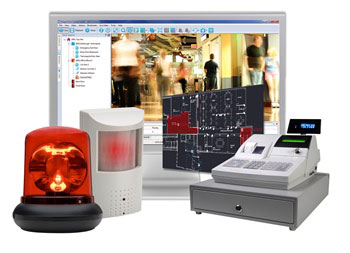
5 reasons why an IP system would better help achieve your security objectives (even if your analog cameras are still working)
Organizations working with old Analog security systems often find that they are unable to meet their main security objectives to reduce crime, improve incident response, increase conviction rates and enhance operational efficiency, due to the limitations of these systems. Below we explore 5 reasons why migrating to an IP surveillance system would better help achieve your security objectives, even if your Analog cameras are still working.
A major reason that some organizations are still operating Analog systems is because the actual technology is still working OK, so some people may think: why change it?
The truth is that Analog systems are just not designed to function well in today’s integrated and technology-driven world. It can be baffling for security managers used to modern IP based security systems to be put in charge of an Analog system, because the limitations of Analog can make it harder to reach your security objectives. For further information on migrating your system from Analog to IP technology, you can attend the upcoming CPD Training Webinar.
1. Get better evidence from your security cameras
When comparing the footage from Analog and High Definition (HD) IP cameras, the difference in quality is huge. HD camera footage is such an improvement because the pixel count is much higher, and means that IP cameras can easily make out the numbers on a License Plate from 20m away, which is something that Analog cameras simply can’t do. An IP surveillance camera is therefore able to scrutinize vehicles of interest from greater distances and with greater accuracy, providing more robust evidence for your investigations.
Pan-Tilt-Zoom (PTZ) IP cameras enable a larger geographical area to be covered with fewer cameras because operators can remote control one PTZ to cover an area that would previously have required several fixed cameras to cover all the angles. This makes it easier for your security team to manage the system, even if they are working on a large city-wide application.
During a live incident, IP systems enable operators to make better and faster decisions to resolve it: the advanced IP camera technology allows your security staff more closely follow a suspect or vehicle due to the higher quality of footage and the decreased latency if remote-controlling the cameras. HD IP cameras also allow increased accuracy for automated analytics and alarms because the cameras can more accurately identify a suspect through, for example, facial recognition software. This vastly improves operational efficiency of your security team, because time is not wasted on false alarms.
This improved video quality provides security managers with evidence that can directly be used in prosecutions: positive identification of a suspect can be made directly from the camera footage, so IP security systems have directly helped to increase crime conviction rates.

2. Ensure 24/7 safety and security for people and property
The prime objective of security systems – to ensure the safety of people and property – depends on the system being operational every moment of the day. Systems which experience periods of downtime are taking a risk with the safety of the people they intended to protect.
Analog systems are more likely to experience downtime than IP systems due to the limitations that the systems have: each camera connects through a wire to a monitor which can therefore only be displayed in one place, usually a main Control Room. This creates a single point of failure, whereby if the electricity fails in the Control Room, for example, there is no way for operators to view live video. If this happened during a serious incident, your security system would not be able to meet its ultimate objective i.e. to protect people and/or property. The lack of flexibility of viewing video has been solved by IP based security systems through remote accessibility, where users can access real-time video at any time, anywhere, from any authorized computer.
IP surveillance systems can also have failovers (i.e. backups) built into them, which is something that Analog systems can’t do, for example a back-up NVR can step in if another fails to ensure no video footage is lost during the outage. This makes IP systems more agile and reliable than their Analog counterparts, because their structure ensures that if some system components fail, your system will still continue to meet its primary objective of ensuring safety.

3. Future-proof your surveillance system
Video surveillance systems are not static entities, and are installed with the view that it is highly likely that system components will change or the system will expand, based on changing technology or the needs of the organization. The majority of Analog hardware is now End of Life technology which means that it’s no longer being manufactured: this makes product replacements scarce and for this reason they are also sold at a premium. This means Analog technology is not a long-term option to use as components in the latest security systems.
IP technology is current so replacement parts are easily accessible, plus they are much more flexible to build security systems with. You can either invest in a fully IP based security system, or you can build hybrid versions which integrate legacy Analog cameras, meaning your investment isn’t so high in the first instance. New IP cameras can then be added at any time, enabling you to migrate to a fully IP based security system as your budget allows.

4. Integrate Advanced Intelligence to enhance your operations
A major advantage of IP based security systems is that through integrations, you are able to take intelligence from other systems to enhance your operations and get better investigative results. You can integrate with other systems such as access control, fire alarms, intruder management and general building management. For example, housing associations that manage several large blocks of flats operating on an Analog security system would employ a concierge at the front desk of each building, often working shifts to provide 24/7 security. With IP based systems, security teams have been able to consolidate their operations into one main control room, where staff can manage a wider variety of tasks, such as intercoms and access control for pedestrians and vehicles, as well as alarms from across the different buildings.
Analytics software and Artificial Intelligence (AI) integrated into IP cameras help to increase the efficiency and effectiveness of security staff during incident response, by only driving operators to act when necessary, when exceptions to the norm occur. The ability for AI to automatically search video and flag important footage – whether based on an event or positive identification of a person – reduces the time it takes for security staff to identify relevant images and avoids human error when you are dealing with hours of footage throughout the day. AI advancements also provide practical tools to safeguard a facility, for example through License Plate Recognition software, people counting, and facial recognition.

5. Save system and operational costs in IP based systems
There are multiple ways that IP systems can be more cost-effective than Analog equivalents. IP security systems run on internet networks using generic hardware, so existing investment in IT infrastructure and devices can often be leveraged as part of a new IP system, which also helps by using equipment that staff are already familiar using.
Better evidence from IP cameras saves organizations money by making it more likely that you are able to identify and then catch suspects, in many cases also getting back the stolen goods. Additionally, many organizations find that they are able to avoid expensive litigation processes because HD camera images are often able to disprove false insurance claims.
In Analog systems, control rooms tend to consume high levels of electricity because each camera in the system is connected to a monitor. When the monitors are running constantly, they tend to get very hot. In order to provide a comfortable environment for security staff (and also to stop the equipment from overheating) it is usually necessary to invest in cooling technology to maintain a steady ambient temperature. This means that not only are you paying for the electricity causing the room to heat up, you’re also paying for the electricity required to cool it down. IP cameras on the other hand can be powered by switches and multiple cameras can be viewed from one monitor – saving both space and electricity by consolidating the amount of equipment required in one room, which consequently saves you money.

IP based systems are the long-term option for organizations looking to meet and enhance their security objectives in the future, with the aim to reduce crime, improve incident response, increase conviction rates and enhance operational efficiency. The upcoming CPD Training Webinar “Making the Leap: Analog to IP Migration” will help to answer any questions you may have when upgrading your system.








